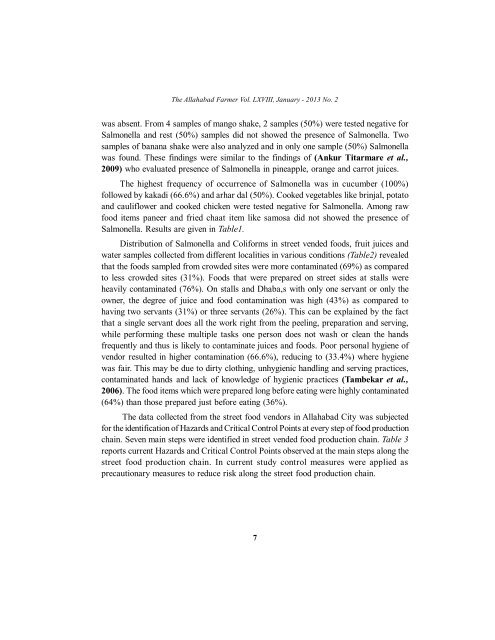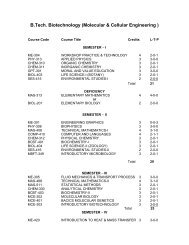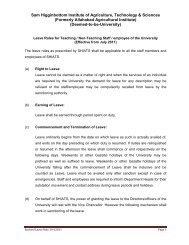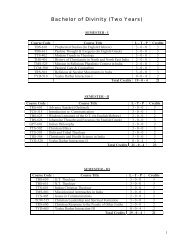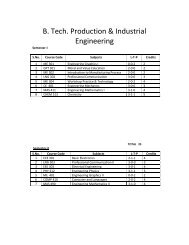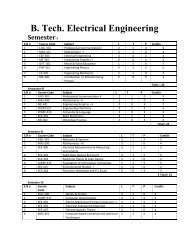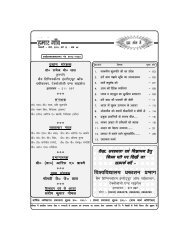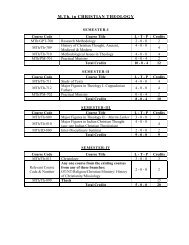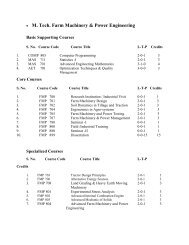Study of Hygienic practices of street food vendors in ... - Shiats.edu.in
Study of Hygienic practices of street food vendors in ... - Shiats.edu.in
Study of Hygienic practices of street food vendors in ... - Shiats.edu.in
Create successful ePaper yourself
Turn your PDF publications into a flip-book with our unique Google optimized e-Paper software.
The Allahabad Farmer Vol. LXVIII, January - 2013 No. 2was absent. From 4 samples <strong>of</strong> mango shake, 2 samples (50%) were tested negative forSalmonella and rest (50%) samples did not showed the presence <strong>of</strong> Salmonella. Twosamples <strong>of</strong> banana shake were also analyzed and <strong>in</strong> only one sample (50%) Salmonellawas found. These f<strong>in</strong>d<strong>in</strong>gs were similar to the f<strong>in</strong>d<strong>in</strong>gs <strong>of</strong> (Ankur Titarmare et al.,2009) who evaluated presence <strong>of</strong> Salmonella <strong>in</strong> p<strong>in</strong>eapple, orange and carrot juices.The highest frequency <strong>of</strong> occurrence <strong>of</strong> Salmonella was <strong>in</strong> cucumber (100%)followed by kakadi (66.6%) and arhar dal (50%). Cooked vegetables like br<strong>in</strong>jal, potatoand cauliflower and cooked chicken were tested negative for Salmonella. Among raw<strong>food</strong> items paneer and fried chaat item like samosa did not showed the presence <strong>of</strong>Salmonella. Results are given <strong>in</strong> Table1.Distribution <strong>of</strong> Salmonella and Coliforms <strong>in</strong> <strong>street</strong> vended <strong>food</strong>s, fruit juices andwater samples collected from different localities <strong>in</strong> various conditions (Table2) revealedthat the <strong>food</strong>s sampled from crowded sites were more contam<strong>in</strong>ated (69%) as comparedto less crowded sites (31%). Foods that were prepared on <strong>street</strong> sides at stalls wereheavily contam<strong>in</strong>ated (76%). On stalls and Dhaba,s with only one servant or only theowner, the degree <strong>of</strong> juice and <strong>food</strong> contam<strong>in</strong>ation was high (43%) as compared tohav<strong>in</strong>g two servants (31%) or three servants (26%). This can be expla<strong>in</strong>ed by the factthat a s<strong>in</strong>gle servant does all the work right from the peel<strong>in</strong>g, preparation and serv<strong>in</strong>g,while perform<strong>in</strong>g these multiple tasks one person does not wash or clean the handsfrequently and thus is likely to contam<strong>in</strong>ate juices and <strong>food</strong>s. Poor personal hygiene <strong>of</strong>vendor resulted <strong>in</strong> higher contam<strong>in</strong>ation (66.6%), r<strong>edu</strong>c<strong>in</strong>g to (33.4%) where hygienewas fair. This may be due to dirty cloth<strong>in</strong>g, unhygienic handl<strong>in</strong>g and serv<strong>in</strong>g <strong>practices</strong>,contam<strong>in</strong>ated hands and lack <strong>of</strong> knowledge <strong>of</strong> hygienic <strong>practices</strong> (Tambekar et al.,2006). The <strong>food</strong> items which were prepared long before eat<strong>in</strong>g were highly contam<strong>in</strong>ated(64%) than those prepared just before eat<strong>in</strong>g (36%).The data collected from the <strong>street</strong> <strong>food</strong> <strong>vendors</strong> <strong>in</strong> Allahabad City was subjectedfor the identification <strong>of</strong> Hazards and Critical Control Po<strong>in</strong>ts at every step <strong>of</strong> <strong>food</strong> productioncha<strong>in</strong>. Seven ma<strong>in</strong> steps were identified <strong>in</strong> <strong>street</strong> vended <strong>food</strong> production cha<strong>in</strong>. Table 3reports current Hazards and Critical Control Po<strong>in</strong>ts observed at the ma<strong>in</strong> steps along the<strong>street</strong> <strong>food</strong> production cha<strong>in</strong>. In current study control measures were applied asprecautionary measures to r<strong>edu</strong>ce risk along the <strong>street</strong> <strong>food</strong> production cha<strong>in</strong>.7


